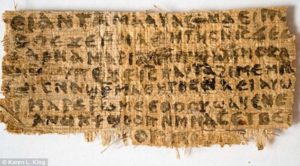Back in September I posted the news and reaction to a discovery by Harvard Professor Karen King of a papyrus document which quoted Jesus as referring to his wife. It unleashed a lot of news coverage, as these things usually do. Here was an ancient source showing that Jesus had a wife.
What went completely unnoticed by the media (I hadn’t even heard) was the growing consensus on the final verdict on this document: It’s a fake. And not even an ancient fake. It’s probably a modern fake.
In this detailed study of the document by Andrew Bernhard of Oxford University, he gives these observations:
The Gospel of Jesus’s Wife (Gos. Jes. Wife) appears to be a modern forgery created using Michael Grondin’s Interlinear Coptic-English Translation of the Gospel of Thomas. Grondin’s Interlinear is a page-by-page, line-by-line edition/translation of the Gospel of Thomas (Gos. Thom.) known from Nag Hammadi Codex II (NHC II).
General Observations:
-
The Gospel of Jesus’ Wife borrows the framework for a simple dialogue between Jesus and his disciples from Gos. Thom. 12.
-
All decipherable words in Gos. Jes. Wife appear in Gos. Thom. with a single exception: “my wife.”
-
The words of each line of text in Gos. Jes. Wife are found in close proximity to each other in Gos. Thom.
-
The forger has slightly redacted Gos. Thom. by making masculine pronouns feminine and (attempting to) transform affirmative/negative statements into their opposites.
-
More than half a dozen notable textual features in Gos. Jes. Wife can be attributed to a forger’s dependence on Grondin’s Interlinear.
He then goes on to say:
I think it is now fair to begin openly describing Gos. Jes. Wife as a modern forgery. Although it is admittedly a novel type of forgery,4 its text can be explained too easily and too completely as a “patchwork” of words and short phrases drawn from the Gos. Thom. by a forger relying on Grondin’s Interlinear. The possibility that Gos. Jes. Wife is a genuinely ancient writing seems extremely remote.
The forger’s “fingerprints” are discernible in every line of text that has more than one word in it. In line 1, the forger has reproduced a typographical error from Grondin’s Interlinear (the omission of a direct object marker) … it seems clear that a forger tried to compose the line of Coptic while thinking in English…
In the end, only a single Coptic word in Gos. Jes. Wife could not have been copied directly from Gos. Thom. This word, which instantly transformed Gos. Jes. Wife into an international sensation, appears near the center of the small papyrus fragment. It is a compound of a possessive article and feminine noun that could easily have been formed by anyone using Grondin’s. Interlinear and the most widely available Coptic-English dictionary in the world..[the word for] “my wife”.
Peter Williams, Warden of the Research Library Tyndale House in England, published these thoughts:
What now?
The story is not finished. At this point, it is unclear whether the Harvard Theological Review, the scholarly journal which was originally supposed to publish the fragment, will in fact do so. There are still tests on the ink to be completed.
Nevertheless, even if the non-invasive tests on the ink turn out compatible with an ancient origin of the script, such tests would only tip the balance of arguments slightly in favour of authenticity. The very serious objections, of which only a selection have been given here, would remain.
Of course, even in the unlikely scenario that these objections were overcome and the scrap deemed ‘authentic’, all we would be left with would be an undated fragment representing the thoughts of an unknown writer some stage before the ninth century when papyrus went out of use. In such a case, even King herself admits that the manuscript would tell us nothing historical about Jesus.
Christians have been quick to point out that, in the Book of Revelation, Christ does have a bride – the church. So it looks like the orthodox rather than the heretics were the first to attribute romance to Jesus, but of a different kind from that for which our culture itches.
What do we learn from all this?
First, we see a number of layers of spin in this tale. Dr. King’s original decision to call the media and to label the fragment a ‘Gospel’ just set the ball rolling. Soon media reports copied each other, and started to suggest that this was a discovery to revolutionise or challenge Christian teaching. By the time this arrived at popular perception, the transformation was complete: a piece of historical evidence suggested that Jesus actually had a wife. The majority impression given by the media was that this was an authentic piece, and the message that, even if genuine, the fragment was of little historical consequence was not heard. Public attitude will have been affected for the worse. So we are reminded that the secular media appear incredibly powerful at getting false messages across which it is hard for us to redress.
Secondly, it could have been worse. To her credit, from the beginning Dr. King released high resolution photos and the technical information she had. This enabled quick scrutiny. Had the person responsible for the fake been better at his or her job the story could have had yet more negative impact…


Why am I not surprised at all? It would be interesting to hear from the creator of this fragment to see exactly what they thought they were doing.